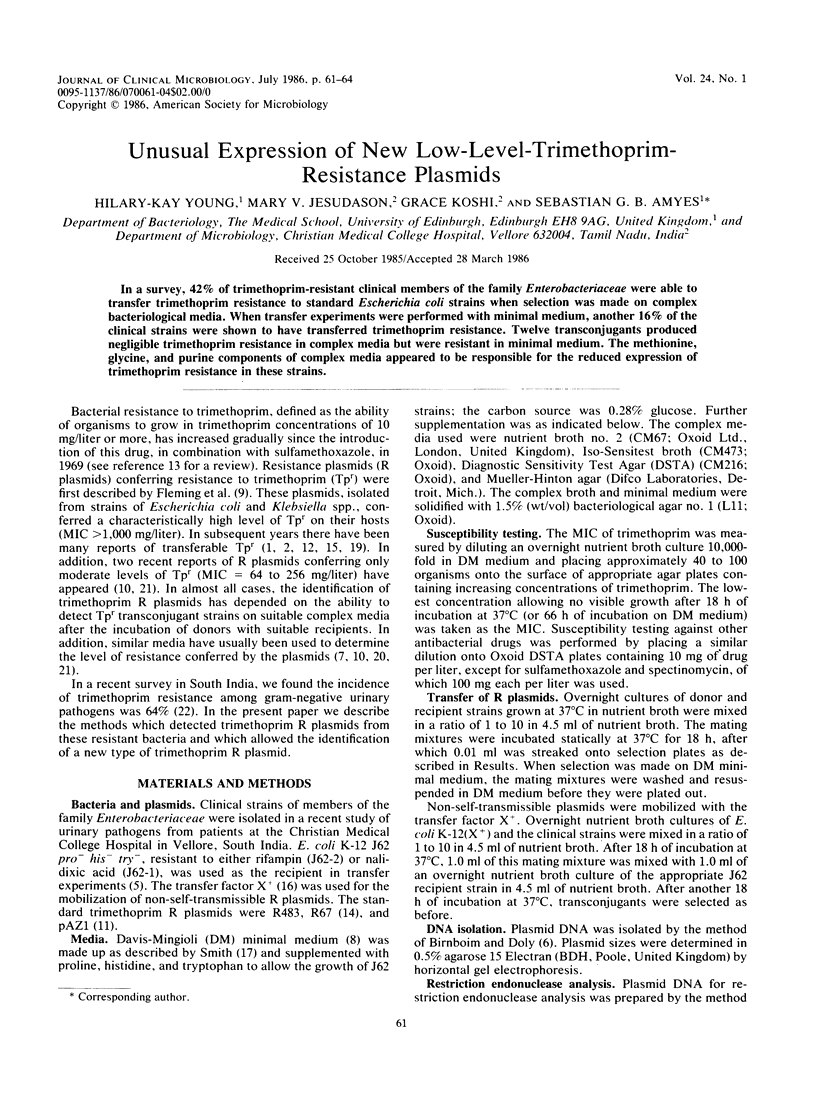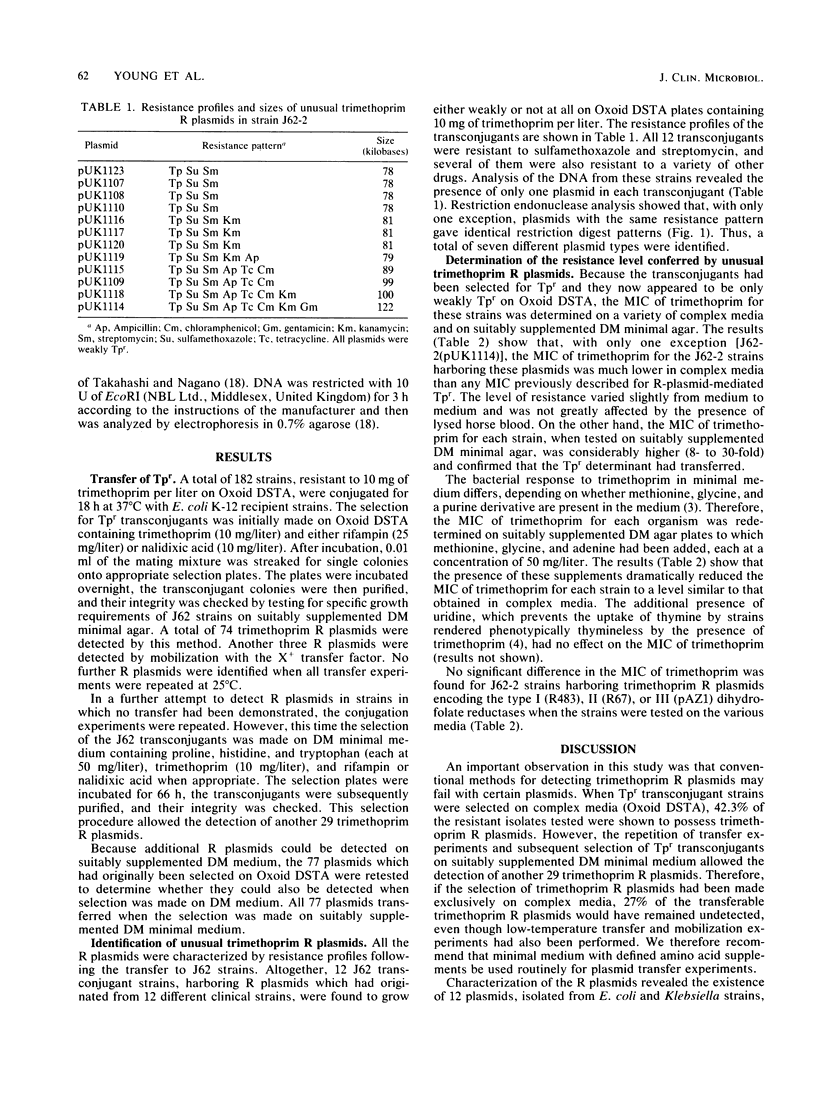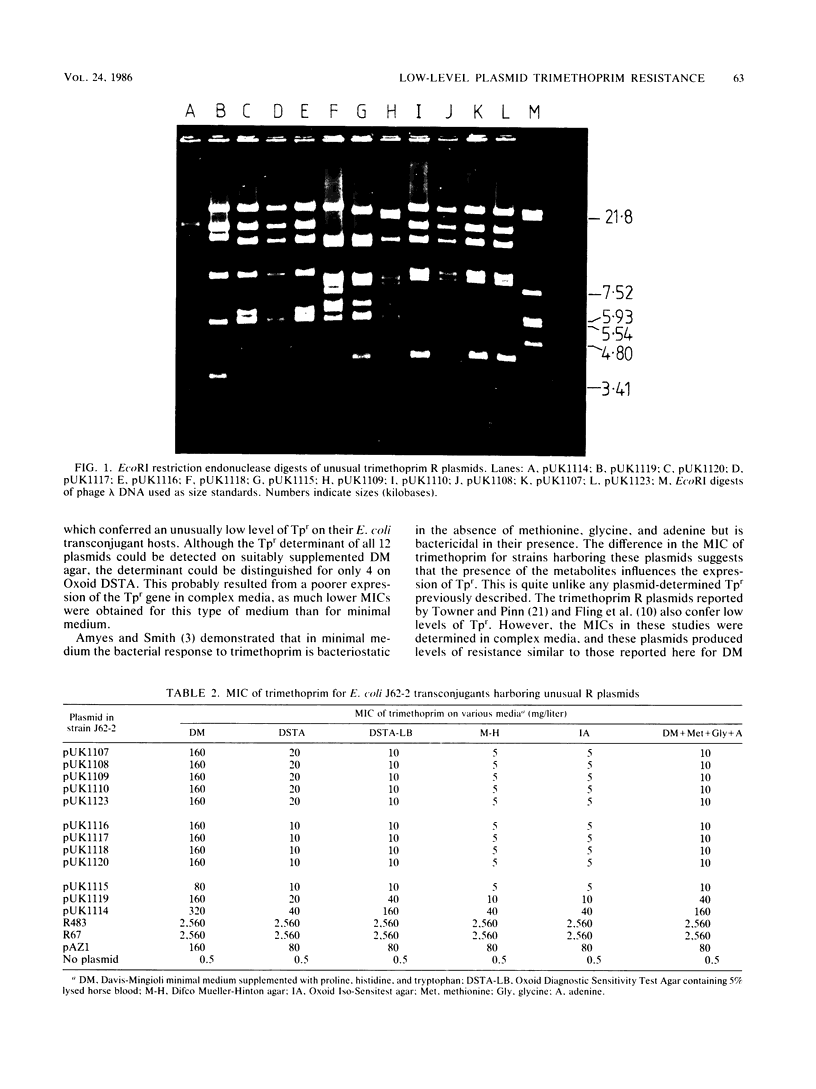Abstract
In a survey, 42% of trimethoprim-resistant clinical members of the family Enterobacteriaceae were able to transfer trimethoprim resistance to standard Escherichia coli strains when selection was made on complex bacteriological media. When transfer experiments were performed with minimal medium, another 16% of the clinical strains were shown to have transferred trimethoprim resistance. Twelve transconjugants produced negligible trimethoprim resistance in complex media but were resistant in minimal medium. The methionine, glycine, and purine components of complex media appeared to be responsible for the reduced expression of trimethoprim resistance in these strains.
Full text
PDF



Images in this article
Selected References
These references are in PubMed. This may not be the complete list of references from this article.
- Acar J. F., Goldstein F. W., Gerbaud G. R., Chabbert Y. A. Plasmides de résistance au triméthoprime: transférabilité et groupes d'incompatibilité. Ann Microbiol (Paris) 1977 Jan;128A(1):41–47. [PubMed] [Google Scholar]
- Amyes S. G., Emmerson A. M., Smith J. T. R-factor mediated trimethoprim resistance: result of two three-month clinical surveys. J Clin Pathol. 1978 Sep;31(9):850–854. doi: 10.1136/jcp.31.9.850. [DOI] [PMC free article] [PubMed] [Google Scholar]
- Amyes S. G., Smith J. T. Trimethoprim action and its analogy with thymine starvation. Antimicrob Agents Chemother. 1974 Feb;5(2):169–178. doi: 10.1128/aac.5.2.169. [DOI] [PMC free article] [PubMed] [Google Scholar]
- Amyes S. G., Smith J. T. Trimethoprim antagonists: effect of uridine on thymine uptake in mineral salts medium. J Antimicrob Chemother. 1978 Sep;4(5):415–419. doi: 10.1093/jac/4.5.415. [DOI] [PubMed] [Google Scholar]
- Bachmann B. J. Pedigrees of some mutant strains of Escherichia coli K-12. Bacteriol Rev. 1972 Dec;36(4):525–557. doi: 10.1128/br.36.4.525-557.1972. [DOI] [PMC free article] [PubMed] [Google Scholar]
- Birnboim H. C., Doly J. A rapid alkaline extraction procedure for screening recombinant plasmid DNA. Nucleic Acids Res. 1979 Nov 24;7(6):1513–1523. doi: 10.1093/nar/7.6.1513. [DOI] [PMC free article] [PubMed] [Google Scholar]
- DAVIS B. D., MINGIOLI E. S. Mutants of Escherichia coli requiring methionine or vitamin B12. J Bacteriol. 1950 Jul;60(1):17–28. doi: 10.1128/jb.60.1.17-28.1950. [DOI] [PMC free article] [PubMed] [Google Scholar]
- Datta N., Hughes V. M., Nugent M. E., Richards H. Plasmids and transposons and their stability and mutability in bacteria isolated during an outbreak of hospital infection. Plasmid. 1979 Apr;2(2):182–196. doi: 10.1016/0147-619x(79)90037-4. [DOI] [PubMed] [Google Scholar]
- Fleming M. P., Datta N., Grüneberg R. N. Trimethoprim resistance determined by R factors. Br Med J. 1972 Mar 18;1(5802):726–728. doi: 10.1136/bmj.1.5802.726. [DOI] [PMC free article] [PubMed] [Google Scholar]
- Fling M. E., Walton L., Elwell L. P. Monitoring of plasmid-encoded, trimethoprim-resistant dihydrofolate reductase genes: detection of a new resistant enzyme. Antimicrob Agents Chemother. 1982 Nov;22(5):882–888. doi: 10.1128/aac.22.5.882. [DOI] [PMC free article] [PubMed] [Google Scholar]
- Joyner S. S., Fling M. E., Stone D., Baccanari D. P. Characterization of an R-plasmid dihydrofolate reductase with a monomeric structure. J Biol Chem. 1984 May 10;259(9):5851–5856. [PubMed] [Google Scholar]
- Kraft C. A., Platt D. J., Timbury M. C. Trimethoprim resistance in urinary coliforms from patients in the community: plasmids and R-transfer. J Antimicrob Chemother. 1985 Mar;15(3):311–317. doi: 10.1093/jac/15.3.311. [DOI] [PubMed] [Google Scholar]
- Lacey R. W. Do sulphonamide-trimethoprim combinations select less resistance to trimethoprim than the use of trimethoprim alone? J Med Microbiol. 1982 Nov;15(4):403–427. doi: 10.1099/00222615-15-4-403. [DOI] [PubMed] [Google Scholar]
- Pattishall K. H., Acar J., Burchall J. J., Goldstein F. W., Harvey R. J. Two distinct types of trimethoprim-resistant dihydrofolate reductase specified by R-plasmids of different compatibility groups. J Biol Chem. 1977 Apr 10;252(7):2319–2323. [PubMed] [Google Scholar]
- Romero E., Perduca M. Compatibility groups of R-factors for trimethoprim resistance isolated in Italy. J Antimicrob Chemother. 1977 Nov;3 (Suppl 100):35–38. doi: 10.1093/jac/3.suppl_c.35. [DOI] [PubMed] [Google Scholar]
- Sharma P. L., Sharma K. B., Prakash K. Incidence of conjugative plasmid amongst multidrug resistant Salmonella typhimurium strains isolated from different parts of India (1979-1982). Indian J Med Res. 1984 Apr;79:473–478. [PubMed] [Google Scholar]
- Smith J. T. R-factor gene expression gram-negative bacteria. J Gen Microbiol. 1969 Jan;55(1):109–120. doi: 10.1099/00221287-55-1-109. [DOI] [PubMed] [Google Scholar]
- Takahashi S., Nagano Y. Rapid procedure for isolation of plasmid DNA and application to epidemiological analysis. J Clin Microbiol. 1984 Oct;20(4):608–613. doi: 10.1128/jcm.20.4.608-613.1984. [DOI] [PMC free article] [PubMed] [Google Scholar]
- Towner K. J., Pearson N. J., Cattell W. R., O'Grady F. Trimethoprim R plasmids isolated during long-term treatment of urinary tract infection with co-trimoxazole. J Antimicrob Chemother. 1979 Jan;5(1):45–52. doi: 10.1093/jac/5.1.45. [DOI] [PubMed] [Google Scholar]
- Young H. K., Amyes S. G. A new mechanism of plasmid trimethoprim resistance. Characterization of an inducible dihydrofolate reductase. J Biol Chem. 1986 Feb 25;261(6):2503–2505. [PubMed] [Google Scholar]



